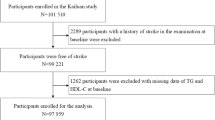Abstract
Epidemiological studies show that increased plasma total homocysteine (tHcy) level was an independent risk factor of cardiovascular diseases. This study was aimed to investigate the relationship between tHcy level and prognosis of first-onset stroke in Chinese people. One hundred ninety six patients with first-onset ischemic stroke and ninety-five patients with first-onset hemorrhagic stroke were enrolled in this study. The patients were divided into two groups in terms of tHcy level (< 18 μmol/L and ⩾ 18 μmol/L). The plasma tHcy level was detected by a high performance liquid chromatography method with fluorescence detection. All the patients underwent a 5-year follow-up. Survival analysis shows that the probability of death or new vascular events in the ischemic stroke patients with high tHcy level (⩾ 18 μmol/L) was significantly higher than that in the counterparts with lower tHcy level (< 18 μmol/L) (50.9% and 28.7%, respectively, P = 0.004). The relative risk of death or new vascular events was 2.363 (95% CI, 1.209 to 4.617, P = 0.012) in ischemic stroke patients with high tHcy levels(⩾ 18 μmol/L) compared to those with a lower tHcy level (< 18 μmol/L). The increased tHcy level was significantly associated with the risk of death or new vascular events (OR, 2.492, 95% CI, 1.148 to 5.407, P = 0.021) in patients with ischemic stroke in the exclusion of the influence of other risk factors such as gender, age, body mass index, plasma cholesterol level, the history of hypertension, diabetes or smoking. However, in the patients with hemorrhagic stroke, there was no significant difference in the probability of death or new vascular events between patients with a high tHcy level and those with a lower tHcy level (33.3% and 28.2%, respectively, P = 0.546). Increased tHcy level was an independent risk factor for a worse outcome in patients with first-onset ischemic stroke, but not in hemorrhagic stroke patients.
Similar content being viewed by others
References
Hankey G J, Eikelboom J W. Homocysteine and vascular disease. Lancet, 1999, 354(9176): 407–413
Durand P, Prost M, Loreau N, Lussier-Cacan S, Blache D. Impaired homocysteine metabolism and atherothrombotic disease. Lab Invest, 2001, 81(5): 645–672
Eikelboom J W, Lonn E, Genest J Jr, Hankey G, Yusuf S. Homocyst(e)ine and cardiovascular disease: a critical review of the epidemiologic evidence. Ann Intern Med, 1999, 131(5):363–375
Boushey C J, Beresford S A, Omenn G S, Motulsky A G. A quantitative assessment of plasma homocysteine as a risk factor for vascular disease: probable benefits of increasing folic acid intakes. JAMA, 1995, 274(13): 1049–1057
Wald D S, Law M, Morris J K. Homocysteine and cardiovascular disease: evidence on causality from a meta-analysis. BMJ, 2002, 325(7374): 1202
Klerk M, Verhoef P, Clarke R, Blom H J, Kok F J, Schouten E G. MTHFR 677C→T polymorphism and risk of coronary heart disease: a meta-analysis. JAMA, 2002, 288(16): 2023–2031
The Homocysteine Studies Collaboration. Homocysteine and risk of ischemic heart disease and stroke: a meta-analysis. JAMA, 2002, 288(16): 2015–2022
McCully K S. Vascular pathology of homocysteinemia: implications for the pathogenesis of atherosclerosis. Am J Pathol, 1969, 56(1): 11–128
Faraci F M, Lentz S R. Hyperhomocysteinemia, oxidative stress, and cerebral vascular dysfunction. Stroke, 2004, 35(2):345–347
Zhang C. Cai Y, Adachi MT, Oshiro S, Aso T, Kaufman R J, Kitajima S. Homocysteine induces programmed cell death in human vascular endothelial cells through activation of the unfolded protein response. J Biol Chem, 2001, 276(38):35867–35874
Tofler G H, D’Agostino R B, Jacques P F, Bostom A J, Wilson P W, Lipinska I, Mittleman M A, Selhub J. Association between increased homocysteine levels and impaired fibrinolytic potent: potential mechanism for cardiovascular risk. Thromb Haemost, 2002, 88(5): 799–804
Lonn E, Yusuf S, Arnold M J, Sheridan P, Pogue J, Micks M, McQueen M J, Probstfield J, Fodor G, Held C, Genest J Jr; Heart Outcomes Prevention Evaluation (HOPE) 2 Investigators. Homocysteine lowering with folic acid and B vitamin in vascular disease. N Engl J Med, 2006, 354(15):1567–1577
Bonaa K H, Njolstad I, Ueland P M, Schirmer H, Tverdal A, Steigen T, Wang H, Nordrehaug J E, Amesen E, Rasmussen K; NORVIT Trial Investigators. Homocysteine lowering and cardiovascular events after acute myocardial infarction. N Engl J Med, 2006, 354(15): 1578–1588
Dusitanond P, Eikelboom J W, Hankey G J, Thom J, Gilmore G, Loh K, Yi Q, Klijn C J, Langton P, van Bockxmeer F M, Baker R, Jamrozik K. Homocysteine-lowering treatment with folic acid, cobalamin, and pyridoxine does not reduce blood markers of inflammation, endothelial dysfunction, or hypercoagulability in patients with previous transient ischemic attack or stroke: a randomized substudy of the VITATOPS trial. Stroke, 2005, 36(1): 144–146
Van Guelpen B, Hultdin J, Johansson I, Stegmayr B, Hallmans G, Nilsson T K, Weinehall L, Witthoft C, Palmqvist R, Winkvist A. Folate, vitamin B12, and risk of ischemic and hemorrhagic stroke: a prospective, nested casereferent study of plasma concentrations and dietary intake. Stroke, 2005, 36(7): 1426–1431
Author information
Authors and Affiliations
Corresponding author
Rights and permissions
About this article
Cite this article
Yan, J., Yue, Z., Shao, J. et al. Predication of increased plasma homocysteine level on the prognosis of Chinese patients with first-onset ischemic stroke. Front. Med. China 2, 352–355 (2008). https://doi.org/10.1007/s11684-008-0067-1
Received:
Accepted:
Published:
Issue Date:
DOI: https://doi.org/10.1007/s11684-008-0067-1




